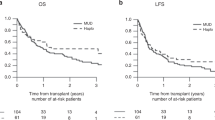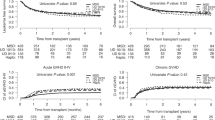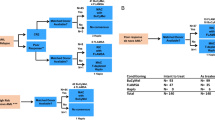Abstract
Allogeneic bone marrow transplantation (BMT) offers a potential cure for younger patients with myelodysplastic syndromes (MDS) or secondary acute myeloid leukemia (sAML). More than 600 patients from 50 European centers have now been reported to the European Group for Blood and Marrow Transplantation (EBMT). We retrospectively analyzed 131 patients reported to the Chronic Leukemia Working Party of the EBMT who underwent BMT from HLA-identical siblings without prior remission induction chemotherapy. At the time of BMT 46 patients had refractory anemia (RA) or RA with ringed sideroblasts, 67 patients had more advanced MDS subtypes and 18 patients had progressed to sAML. The 5-year disease-free (DFS) and overall survival (OS) for the entire group of patients was 34 and 41%, respectively. Fifty patients died from transplant-related complications, most commonly graft-versus-host disease and/or infections. Relapse occurred in 28 patients between 1 and 33 months after BMT, resulting in an actuarial probability of relapse of 39% at 5 years. DFS and OS were dependent on pretransplant bone marrow blast counts. Patients with RA/RARS, RAEB, RAEB/T and sAML had a 5-year DFS of 52, 34, 19 and 26%, respectively. The 5-year OS for the respective patient groups was 57, 42, 24 and 28%. In a multivariate analysis, younger age, shorter disease duration, and absence of excess of blasts were associated with improved outcome. From these data we conclude that patients with myelodysplasia who have appropriate marrow donors, especially those aged less than 40 years and those with low medullary blast cell count should be treated with BMT as the primary treatment early in the course of their disease. Transplantation early after establishing the diagnosis of MDS may improve prognosis due to a lower treatment-related mortality and a lower relapse risk.
This is a preview of subscription content, access via your institution
Access options
Subscribe to this journal
Receive 12 print issues and online access
$259.00 per year
only $21.58 per issue
Buy this article
- Purchase on Springer Link
- Instant access to full article PDF
Prices may be subject to local taxes which are calculated during checkout
Similar content being viewed by others
Author information
Authors and Affiliations
Consortia
Rights and permissions
About this article
Cite this article
Runde, V., de Witte, T., Arnold, R. et al. Bone marrow transplantation from HLA-identical siblings as first-line treatment in patients with myelodysplastic syndromes: early transplantation is associated with improved outcome. Bone Marrow Transplant 21, 255–261 (1998). https://doi.org/10.1038/sj.bmt.1701084
Received:
Accepted:
Published:
Issue Date:
DOI: https://doi.org/10.1038/sj.bmt.1701084
Keywords
This article is cited by
-
Myelodysplastic syndromes
Nature Reviews Disease Primers (2022)
-
Indications for Allogeneic Hematopoietic Cell Transplantation in Myelodysplastic Syndrome
Current Hematologic Malignancy Reports (2020)
-
Chronic Myelomonocytic Leukemia: 2018 Update to Prognosis and Treatment
Current Hematologic Malignancy Reports (2019)
-
Myeloablative conditioning regimens with combined of haploidentical and cord blood transplantation for myelodysplastic syndrome patients
Bone Marrow Transplantation (2018)
-
Outlook and Management of Patients with Myelodysplastic Syndromes Failed by Hypomethylating Agents
Current Hematologic Malignancy Reports (2015)



